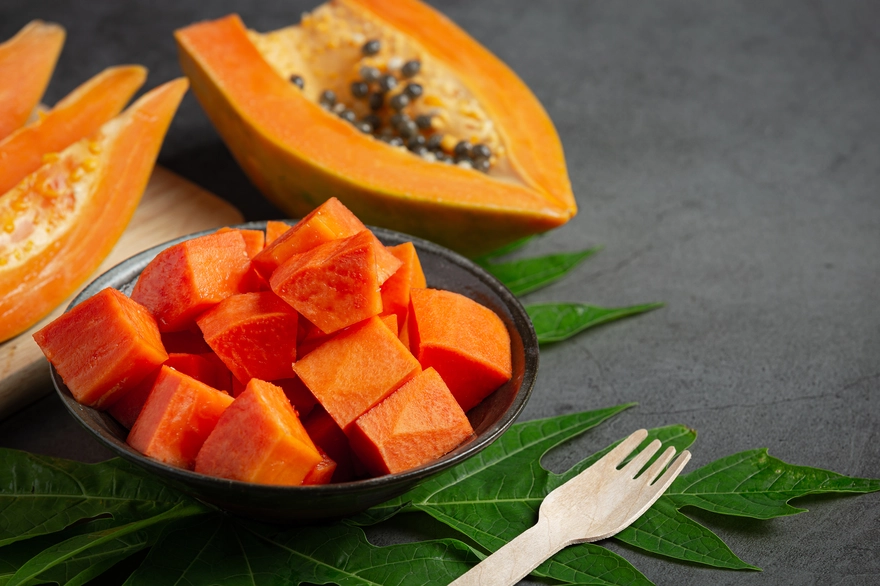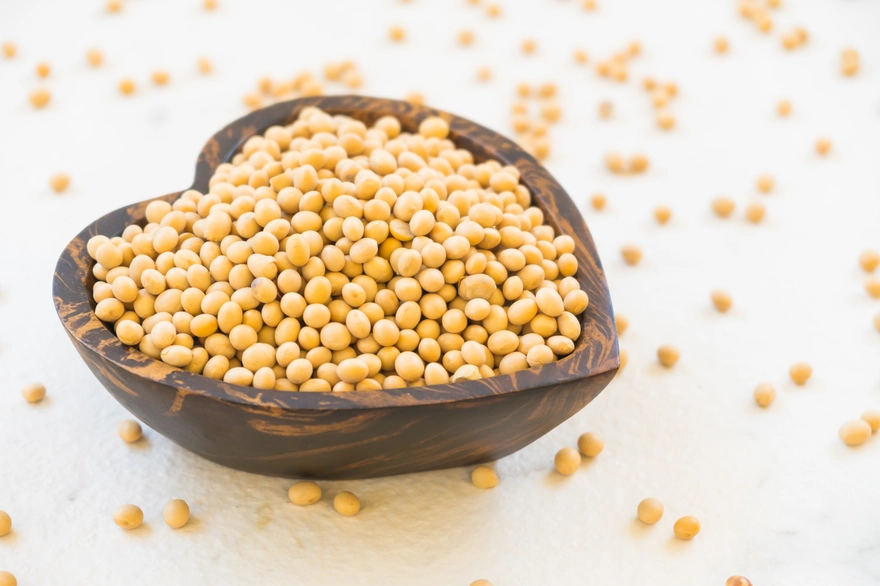Latest Blogs
Benefits of Pineapple in Pregnancy
Is Pineapple Safe During Pregnancy? Expectant mothers often wonder whether it's safe to eat pineapple while pregnant. The good news is that pineapple can be eaten in pregnancy when consumed in moderation. There is no scientific evidence suggesting that eating pineapple poses any harm to pregnant women or their developing babies. One common myth is that the bromelain enzyme in pineapple can induce labour or cause miscarriage. However, the amount of bromelain found in the fruit, especially in the flesh, is too low to have any significant effect on the uterus. The core contains slightly higher levels of bromelain, but it is usually discarded before consumption. Eating fresh or canned pineapple during third trimester in reasonable quantities is considered safe. Nonetheless, it's essential to consume pineapple in moderation to avoid digestive discomfort due to its acidity. Nutritional Benefits of Pineapple for Pregnant Women Having pineapple in pregnancy is considered good as it offers several nutritional benefits for expectant mothers. This tropical fruit is an excellent source of vitamin C, providing over 130% of the recommended daily intake in just one cup. Vitamin C supports the immune system, aids in iron absorption, and promotes collagen production, which is crucial for the baby's growth and development. Furthermore, pineapple contains dietary fibre, which helps maintain digestive health and prevents constipation, a common issue during pregnancy. The fruit also provides essential nutrients like folate, manganese, and vitamin B6, which contribute to foetal development and overall maternal well-being. The high water content in pineapple makes it a hydrating snack option for pregnant women. Staying hydrated is vital during pregnancy to support the increased blood volume and amniotic fluid levels. Debunking Myths About Pineapple in Pregnancy Despite the numerous pineapple benefits in pregnancy, some myths persist about its safety. Let's debunk a few common misconceptions: Myth: Eating pineapple can cause miscarriage, especially in the first trimester. Fact: There is no scientific evidence linking pineapple consumption to an increased risk of miscarriage. The bromelain levels in the fruit are not high enough to affect the uterus or cause harm to the foetus. Myth: Pineapple induces labour and should be avoided near the due date. Fact: While some people believe that pineapple can stimulate labour, there is no concrete evidence to support this claim. Eating pineapple will not trigger premature labour or significantly affect the timing of delivery. Myth: Pregnant women should completely avoid pineapple. Fact: Pineapple is safe and beneficial when consumed in moderation during pregnancy. The key is to eat it in reasonable portions and listen to your body's response. If you have any specific concerns or allergies related to pineapple, it's always best to consult with your healthcare provider for personalised advice. Health Benefits of Pineapple During Pregnancy Pineapple in pregnancy can offer several health benefits, making it a nutritious addition to your diet. Beyond its vibrant flavour, this tropical fruit provides essential nutrients that support both maternal well-being and foetal development. Anti-inflammatory Properties Pineapple contains bromelain, an enzyme with anti-inflammatory properties. Consuming pineapple in pregnancy may help alleviate common discomforts like swelling, joint pain, and inflammation. However, it's important to note that the bromelain content in the fruit alone may not provide significant anti-inflammatory effects. Enhanced Digestive Health The dietary fibre in pineapple promotes digestive health by preventing constipation and maintaining regular bowel movements. Fibre also helps control blood sugar levels and keeps you feeling full for longer, which can be beneficial for managing pregnancy cravings and maintaining a healthy weight. Hydrating Benefits for Expectant Mothers Pineapple has a high water content, making it a refreshing and hydrating snack option during pregnancy. Staying well-hydrated is crucial for maintaining amniotic fluid levels, supporting foetal circulation, and reducing the risk of urinary tract infections. Vitamin B6 for Foetal Development Pineapple is a good source of vitamin B6, which plays a vital role in foetal brain development and nervous system formation. Adequate intake of vitamin B6 during pregnancy also helps alleviate morning sickness symptoms and supports the mother's immune function. Vitamin C Boost for Immunity and Skin Health The high vitamin C content in pineapple strengthens the immune system, helping pregnant women ward off infections. Vitamin C also aids in collagen production, promoting healthy skin elasticity and reducing the appearance of stretch marks. Natural Sweetness without Added Sugars Pineapple's natural sweetness can satisfy pregnancy cravings without the need for added sugars. Opting for fresh pineapple over sugary snacks helps maintain stable blood sugar levels and prevents excessive weight gain. Incorporating pineapple in pregnancy can be a delightful way to boost your nutrient intake while enjoying a naturally sweet and refreshing fruit. Consumed in moderation, pineapple offers a range of benefits that contribute to a healthy and comfortable pregnancy journey. Best Ways to Add Pineapple to Your Pregnancy Diet Incorporating pineapple into your pregnancy diet is easy, delicious, and can add valuable nutrients to your meals. Pineapple is a rich source of vitamin C, which supports immunity, and bromelain, which may aid digestion in moderation. Here are some wonderful ways to enjoy pineapple in pregnancy: Start with fresh pineapple slices as a simple snack or mix them into fruit salads for a refreshing tropical touch. Blend pineapple chunks with yoghurt, milk, or coconut water to create a revitalising smoothie packed with flavour and nutrition. Grill pineapple slices for a sweet and tangy side dish or as a flavourful topping for salads. Add pineapple chunks to stir-fries or curries to introduce a burst of natural sweetness and acidity that balances savoury dishes. For a delightful treat, bake pineapple into muffins, cakes, or bread to enjoy its fruity goodness in baked goods. When choosing pineapple in pregnancy, opt for fresh, ripe fruits with a sweet aroma and firm texture. Avoid overripe or bruised pineapples, which may have higher acidity levels. If using canned pineapple, select options packed in water or natural juices rather than sugary syrups to maintain healthy choices. By including pineapple in pregnancy, you can enjoy its delicious flavour while supporting your nutritional needs with balance and care. Conclusion Pineapple is a safe and nutritious addition to a healthy pregnancy diet when consumed in moderation. This delicious fruit offers a range of benefits, including essential vitamins, fibre, and hydration. By debunking common myths and understanding the best ways to enjoy pineapple in pregnancy. Remember, every pregnancy is unique, and it's always best to consult with your healthcare provider for personalised advice. If you have any concerns about your diet or need guidance on prenatal nutrition, consider reaching out to Metropolis Healthcare. With our expertise in diagnostic testing and commitment to patient care, Metropolis can help you navigate a healthy pregnancy and ensure the well-being of you and your growing baby. FAQ About Pineapple and Pregnancy 1. Is it safe to eat pineapple while pregnant? Yes, pineapple can be eaten in pregnancy in moderation. Pineapple is a nutritious fruit that provides essential vitamins and minerals for both the mother and the developing baby. 2. How much pineapple is safe during pregnancy? Pregnant women can safely consume 1-2 cups of fresh pineapple per day. It's important to listen to your body and avoid overeating pineapple, as its acidity may cause digestive discomfort in some individuals. 3. Is pineapple safe for the first trimester? Yes, pineapple is safe to consume during the first trimester of pregnancy. There is no scientific evidence suggesting that eating pineapple in the early stages of pregnancy increases the risk of miscarriage or harms the foetus. 4. Can pineapple induce labour? While some people believe that eating pineapple can induce labour, there is no conclusive scientific evidence to support this claim. The bromelain enzyme in pineapple is not potent enough to stimulate uterine contractions or significantly affect the timing of labour. 5. How much pineapple juice will cause a miscarriage? There is no specific amount of pineapple juice that has been proven to cause miscarriage. The myth that pineapple juice can lead to miscarriage is not supported by scientific evidence. However, it's always best to consume pineapple juice in moderation and consult with your healthcare provider if you have any concerns.
Effective Home Remedies For Dengue
Dengue fever is a mosquito-borne viral infection caused by the dengue virus, primarily transmitted by the Aedes aegypti mosquito. It is common in tropical and subtropical regions and affects millions worldwide each year. Symptoms often include high fever, severe headaches, joint and muscle pain, skin rashes, and bleeding gums or nose in severe cases. While there’s no specific cure for dengue, treatment focuses on relieving symptoms, staying hydrated, and ensuring proper medical care. Severe cases may require hospitalisation to manage complications like dengue hemorrhagic fever. Alongside medical treatment, certain home remedies for dengue fever can help ease discomfort, support immunity, and aid recovery. In this article, we'll explore 10 effective dengue fever home remedies, including the well-known papaya leaf juice for dengue, and share useful prevention tips. 10 Effective Home Remedies for Dengue Papaya Leaf Juice Papaya leaf juice for dengue is a popular remedy believed to help increase platelet count in patients. While more research is needed, some studies suggest it may support immune function and boost platelet levels. To prepare this remedy, crush fresh papaya leaves, extract the juice, and consume it twice daily. Papaya leaf juice is rich in nutrients and antioxidants, which may aid recovery. However, it should be used alongside proper medical care to ensure safe and effective dengue management. Giloy Juice Giloy juice is one of the well-known natural remedies for dengue fever believed to strengthen the immune system and support recovery. Rich in antioxidants, giloy helps reduce fever, flush out toxins, and improve overall well-being. It is also known for its anti-inflammatory properties, which may ease body aches and discomfort. To use this remedy, boil giloy stems in water, strain the liquid, and drink it once or twice daily to promote healing and boost immunity. Barley Water Barley water is among the beneficial home remedies for dengue fever, known for its ability to support liver function and improve digestion. It’s rich in essential nutrients and antioxidants that help reduce fever and enhance immunity. Barley water is also believed to aid in platelet production, which often drops in dengue patients. To prepare, boil barley in water, strain, and drink it regularly to stay hydrated and accelerate recovery. Coconut Water Dengue fever can cause dehydration, making coconut water an excellent addition to your home remedies for dengue due to its rich electrolyte content, which helps combat dehydration caused by fever and vomiting. It replenishes lost minerals, improves energy levels, and supports overall recovery. Additionally, coconut water contains natural antioxidants that aid in detoxifying the body. Drinking 1-2 glasses of fresh coconut water daily can help maintain fluid balance, reduce fatigue, and promote faster healing during dengue fever. Fenugreek Seeds Fenugreek seeds are among the natural remedies for dengue fever, known for their fever-reducing properties and ability to soothe body aches. Rich in antioxidants, these seeds help boost immunity and fight infections. Fenugreek tea can also promote relaxation and improve sleep, which is essential for recovery. To prepare, soak fenugreek seeds in warm water for a few hours, strain, and drink the infused water 1-2 times daily to reduce fever and ease discomfort. Tulsi or Basil Leaves Tulsi leaves are valued for their antibacterial, antiviral, and anti-inflammatory properties, making them effective home remedies for dengue fever. Consuming tulsi tea can help reduce fever, boost immunity, and improve respiratory health. To prepare, boil a handful of fresh tulsi leaves in water, strain, and drink the tea 2-3 times daily. Chewing fresh tulsi leaves may also provide additional immune support and aid in a quicker recovery from dengue. Neem Leaves Neem leaves are widely recognised for their powerful antibacterial and antiviral properties, making them effective home remedies for dengue fever. Neem helps purify the blood, strengthen immunity, and reduce the risk of secondary infections. To use neem leaves, boil a handful in water, strain the liquid, and drink it once or twice daily. Neem extract can also be applied externally to soothe skin rashes, a common symptom of dengue fever. Turmeric Milk Turmeric milk is a traditional remedy that can support recovery during dengue fever due to its potent anti-inflammatory and antioxidant properties. Curcumin, the active compound in turmeric, helps reduce fever, improve immunity, and promote faster healing. To prepare, mix a teaspoon of turmeric powder into a warm glass of milk and drink it before bedtime. This soothing drink helps reduce inflammation, ease body aches, and support overall recovery. Ginger and Honey Ginger and honey are known for their immune-boosting and anti-inflammatory properties, making them beneficial for managing dengue symptoms. Ginger helps reduce nausea and improve digestion, while honey soothes the throat and provides energy. To prepare, boil sliced ginger in water, strain, and add a teaspoon of honey before drinking. Consuming this mixture 1-2 times daily can help reduce fever, ease discomfort, and support recovery. Pomegranate Juice Pomegranate juice is packed with essential nutrients, antioxidants, and vitamins that can help increase energy levels and improve platelet count in dengue patients. Its rich iron content supports blood production, while antioxidants help reduce fatigue and boost immunity. Drinking a glass of fresh pomegranate juice daily can aid recovery, improve hydration, and enhance overall well-being. For best results, consume freshly prepared juice without added sugar. Tips for Prevention of Dengue Preventing dengue involves controlling mosquito populations and protecting yourself from bites. Here are some tips to reduce your risk of dengue infection: Eliminate standing water: Mosquitoes breed in stagnant water. Remove sources of standing water around your home, such as buckets, old tires, and clogged gutters. Use mosquito repellents: Apply mosquito repellents DEET, picaridin, or oil of lemon eucalyptus when outdoors, especially during peak mosquito hours (dawn and dusk). Wear protective clothing: When in mosquito-prone areas, wear long-sleeved shirts, long pants, and socks to minimize exposed skin. Install window screens: Use window and door screens to prevent mosquitoes from entering your home. Use mosquito nets: Sleep under a mosquito net, especially if you live in a high-risk area or don't have air conditioning. Support community efforts: Participate in community initiatives to control mosquito populations, such as spraying insecticides and educating others about prevention. In areas where dengue is prevalent, consider vaccination if recommended by healthcare authorities and available for your specific demographic. Boost your immunity: Maintain a healthy diet, exercise regularly, and get enough sleep to keep your immune system strong. Remember, if you suspect you have dengue fever, seek medical attention immediately. Early diagnosis and proper medical care are crucial for preventing complications and ensuring a smooth recovery. Why Choose The Dengue Fever Panel Package? If you suspect you have dengue fever, early diagnosis is key to proper treatment and recovery. Metropolis Healthcare's Dengue Fever Panel Package offers comprehensive testing to confirm the diagnosis and monitor your health. The package includes: NS1 Antigen Test: Detects the dengue virus in the early stages of infection IgM Antibody Test: Identifies antibodies produced by the immune system in response to the dengue virus IgG Antibody Test: Helps determine if the infection is primary or secondary Complete Blood Count (CBC): Assesses overall health and monitors platelet levels Conclusion While home remedies for dengue can help manage symptoms and support recovery, they should never replace professional medical care. If you suspect you have dengue fever, consult a healthcare provider immediately for proper diagnosis and treatment. By combining medical care with these dengue fever home remedies, you can aid your body's fight against the virus and promote a faster recovery. By choosing the Dengue Fever Panel Package, you can benefit from Metropolis Healthcare's expertise in diagnostic testing. Our trained phlebotomists offer convenient at-home sample collection, ensuring a comfortable and safe experience. The collected samples are analysed in state-of-the-art laboratories, providing accurate and reliable results. You can easily access your test reports online through email and the user-friendly Metropolis TruHealth app. FAQs 1. What is the best home remedy for dengue? While no single remedy is considered the best, papaya leaf juice for dengue is a popular choice due to its potential to increase platelet count. Other effective home remedies for dengue include giloy juice, neem leaves, and turmeric milk. However, it's essential to consult a healthcare professional before using any home remedies. 2. How to recover from dengue quickly? To support your recovery from dengue fever: Get plenty of rest to help your body fight the infection. Stay hydrated by drinking water, coconut water, and other fluids. Use home remedies for dengue, such as papaya leaf juice, alongside medical treatment. Follow your doctor's advice and take prescribed medications as directed. Eat a balanced diet rich in fruits and vegetables to boost your immunity.
Green Stool: Causes, What It Means, and When to Worry
Noticing green stool or green poop can be unsettling, leaving you wondering about the potential green stool causes and whether it's a sign of a serious health issue. In most cases, green stool in adults is harmless and resolves on its own. However, understanding the meaning of green stool can help you determine if your green poop concerns warrant a visit to the doctor. This article will explore the common causes, associated medical conditions, and when to seek medical advice for green stools. Understanding Stool Colour The colour of your stool can provide valuable insights into your digestive health. Normally, stool appears brown due to the presence of bilirubin, a pigment produced by the liver during the breakdown of red blood cells. As bilirubin moves through the digestive tract, gut bacteria chemically alter it, resulting in the characteristic brown hue. However, certain factors can disrupt this process, leading to green stool. When food moves too quickly through the large intestine, there may not be enough time for gut bacteria to break down the bile pigments completely. This can cause green poop, as the bilirubin retains its original greenish colour. Stool colour can also be influenced by your diet. Consuming large amounts of green leafy vegetables like spinach or kale can give your stool a green tint due to their chlorophyll content. Similarly, food dyes found in certain processed foods, supplements, or medications can also result in green stool. Common Causes of Green Stool Several factors can contribute to the occurrence of green stool or green poop. Some of the most common green stool causes include: Diet: Eating large quantities of green leafy vegetables, such as spinach, kale, or chard, can lead to green stools. These vegetables contain chlorophyll, a green pigment that can pass through your digestive system unchanged, resulting in green poop. Food colouring: Consuming foods or drinks with green food colouring, like green frosting or ice cream, can also cause green stool in adults and children. Supplements: Certain supplements, such as iron or those containing chlorophyll, can alter the colour of your stool, making it appear green. Medications: Some antibiotics, particularly those in the tetracycline family, can lead to green stools by altering the balance of gut bacteria. Gastrointestinal infections: Bacterial infections like Salmonella or E. coli can cause green diarrhoea due to increased gut motility and decreased transit time. In most cases, green stools caused by dietary factors or supplements are temporary and will resolve on their own once you discontinue the triggering food or medication. However, if your green poop concerns persist or are accompanied by other symptoms, it's essential to consult a healthcare provider to rule out any underlying medical conditions. Medical Conditions Linked to Green Stool While dietary factors and supplements are the most common causes of green stool, certain medical conditions can also lead to this change in colour. Some health issues associated with green stools in adults include: Inflammatory bowel disease (IBD): Conditions like Crohn's disease and ulcerative colitis can cause inflammation in the digestive tract, leading to diarrhoea and green stools. These conditions may also cause abdominal pain, bloating, and weight loss. Celiac disease: This autoimmune disorder, triggered by gluten consumption, can damage the small intestine and lead to malabsorption. As a result, people with coeliac disease may experience diarrhoea, green stools, and other gastrointestinal symptoms. Giardiasis: This parasitic infection can cause green, watery diarrhoea, along with abdominal cramps, bloating, and nausea. Giardiasis is often contracted by drinking contaminated water or coming into contact with infected individuals. Bile duct obstruction: A blockage in the bile ducts can prevent bile from properly reaching the small intestine, leading to green-coloured stools. This condition may also cause jaundice, abdominal pain, and fever. If you experience persistent green poop accompanied by other concerning symptoms, it's crucial to consult a healthcare provider for proper diagnosis and treatment. They can help determine the underlying cause of your green stool and recommend appropriate management strategies. When to See a Doctor While occasional green stools are usually not a cause for concern, there are certain situations in which you should seek medical attention. Consult a healthcare provider if you experience: Persistent green stools: If your green poop lasts for more than a few days without any apparent dietary or medication-related cause, it's essential to get checked by a doctor. Severe abdominal pain: If your green stools are accompanied by intense abdominal pain or cramping, it could indicate a more serious underlying condition that requires medical attention. Blood in stool: Bloody stools, whether red or black (tarry), should always be evaluated by a healthcare professional, as they can be a sign of gastrointestinal bleeding or other serious health issues. Unintended weight loss: If you experience unexplained weight loss along with green stools, it's crucial to consult a doctor to rule out any underlying medical conditions. Fever: A fever accompanied by green diarrhoea may indicate a bacterial or parasitic infection that requires prompt medical treatment. Prevention and Management To prevent or manage green stool, consider the following tips: Maintain a balanced diet: Eat a variety of fruits, vegetables, whole grains, and lean proteins to support healthy digestion and regular bowel movements. Stay hydrated: Drink plenty of water throughout the day to prevent dehydration, especially if you experience diarrhoea or rapid bowel movements. Probiotics: If you've recently taken antibiotics or have a history of gastrointestinal issues, consider incorporating probiotic-rich foods (e.g., yoghurt, kefir, sauerkraut) or supplements into your diet to promote a healthy gut flora balance. Avoid trigger foods: If you notice that certain foods consistently lead to green poop or digestive discomfort, try eliminating them from your diet and observe any improvements. Manage stress: Chronic stress can affect gut health and bowel movements. Practice stress-reduction techniques such as meditation, deep breathing exercises, or engaging in relaxing hobbies. Conclusion Green stool can be an unsettling sight, but in most cases, it is a temporary and harmless occurrence caused by dietary factors, medications, or rapid digestive transit. However, if green poop persists or is accompanied by other concerning symptoms, it's crucial to seek medical advice to rule out underlying health issues. By understanding the causes and meaning of green stool, you can take proactive steps to maintain your digestive health and overall well-being. If you have concerns about your stool colour or any other digestive symptoms, consider reaching out to Metropolis Healthcare for our comprehensive diagnostic services. With a network of state-of-the-art laboratories across India, Metropolis Healthcare offers accurate and reliable testing to help you gain insights into your health. Take charge of your digestive health today by booking a test or health check-up with Metropolis Healthcare. FAQs Does green poop mean your liver is going bad? No, green stool alone does not indicate liver problems. Pale or clay-coloured stools may be a sign of liver issues due to reduced bile production or obstruction. What does green stool mean? Green stool can have various meanings depending on the underlying cause, such as dietary factors, medications, rapid digestive transit, or certain medical conditions. Is it OK to have green poop? Occasional green stools are generally not a cause for concern, especially if they can be attributed to diet or medication. However, persistent green stool should be evaluated by a healthcare professional. What virus causes green poop? Viral gastroenteritis, commonly caused by norovirus or rotavirus, can lead to green diarrhoea due to rapid intestinal transit and inflammation. Can pancreas problems cause green poop? While pancreatic issues are not a direct cause of green stool, they can sometimes contribute to digestive problems and changes in stool colour. Can stress cause green poop? Stress itself does not directly cause green stool, but it can exacerbate digestive issues like irritable bowel syndrome (IBS), which may lead to changes in bowel movements and stool colour. When should you be concerned about green poop? You should be concerned about green stool if it persists for more than a few days, is accompanied by severe abdominal pain, fever, or bloody stools, or if you experience persistent diarrhoea or unexplained weight loss. Does green poop mean infection? Green stool can sometimes indicate a gastrointestinal infection, particularly if it is accompanied by other symptoms like diarrhoea, abdominal cramps, or fever. However, not all cases of green poop are caused by infections.
Is Papaya Good for Diabetes?
Is papaya good for diabetes? For those living with diabetes, making informed food choices is crucial. Papaya, a tropical fruit packed with nutrients, has gained attention for its potential to support diabetes management. In this article, we'll explore the connection between papaya and blood sugar levels, examine the papaya benefits for diabetes, and help you understand how this fruit can fit into a diabetes-friendly diet. Whether you're wondering "Is papaya good for diabetes patient?" or seeking natural ways to manage diabetes symptoms, read on to discover the health advantages of papaya. Understanding Papaya and Diabetes Papaya, scientifically known as Carica papaya, is a tropical fruit that offers numerous health benefits, including potential support for those managing diabetes. So, is papaya good for diabetes? The answer lies in its nutritional profile. Papaya has a low glycemic index (GI), meaning it causes a slower rise in blood sugar levels compared to high-GI foods. This makes it a smart choice for individuals looking to maintain stable blood sugar levels. Additionally, papaya is rich in dietary fibre, which slows the digestion and absorption of carbohydrates. This helps regulate glucose levels while promoting satiety, which can aid in weight management—an essential aspect of diabetes care. Moreover, papaya is packed with antioxidants such as vitamin C, which may help reduce oxidative stress, a common concern for those with diabetes. Including papaya in a balanced diet can be a delicious and beneficial way to support overall health. Is Papaya Good for Diabetes? Research suggests that incorporating papaya for diabetes management can be beneficial due to its nutritional profile and antidiabetic properties. Papaya is naturally rich in fibre, antioxidants, and bioactive compounds, all of which may support better blood sugar control. A study published in the Journal of Ethnopharmacology found that papaya leaf extract improved insulin sensitivity and reduced blood glucose levels in diabetic rats. This suggests that certain compounds in papaya may help regulate glucose metabolism. Additionally, research from the Asian Pacific Journal of Tropical Biomedicine revealed that fermented papaya preparation (FPP) improved blood sugar control and reduced oxidative stress in individuals with type 2 diabetes. Papaya contains powerful bioactive compounds such as flavonoids and saponins, which have been shown to enhance insulin sensitivity and lower blood sugar levels. These properties highlight the potential of papaya and blood sugar levels being positively linked. While these findings are encouraging, more human studies are necessary to confirm the full scope of papaya benefits for diabetes. As with any dietary change, it’s important to consult your healthcare provider to determine how papaya can fit into your personalised diabetes care plan. Enjoying papaya in moderation as part of a balanced diet may provide a natural and nutritious way to help manage blood sugar levels while supporting overall health. How Papaya Affects Blood Sugar Levels So, how exactly does papaya influence blood sugar levels? This tropical fruit offers several benefits that can support glucose regulation. Papaya is rich in dietary fibre, which plays a crucial role in slowing down the digestion and absorption of carbohydrates. This process helps prevent sudden spikes in blood sugar levels after meals. Additionally, papaya contains flavonoids, which are known to improve insulin sensitivity. By enhancing the body's response to insulin, these compounds help cells absorb and utilise glucose more effectively. Another valuable component found in papaya is saponins. These bioactive compounds have been shown to reduce glucose absorption in the gut, further supporting balanced blood sugar levels. While papaya can be a beneficial addition to a diabetes-friendly diet, moderation is essential. Eating papaya in appropriate portions helps maximise its benefits without contributing to excessive sugar intake. Including papaya alongside other nutrient-rich foods can be a smart and delicious way to manage blood sugar levels and diabetes symptoms effectively. Nutritional Composition of Papaya Papaya is a nutrient-dense fruit that offers a range of vitamins and minerals, and beneficial compounds. One small papaya (about 157 grams) contains approximately: 67 calories 15 grams of carbohydrates 2.67 grams of dietary fibre 1 gram of protein 0.2 grams of fat 286 mg of potassium 33 mg of magnesium 31 mg of calcium 106% of the daily value for vitamin C This well-rounded nutritional profile makes papaya good for diabetes management. The fibre content, in particular, can help slow down the absorption of sugar into the bloodstream, promoting more stable blood sugar levels. Other Health Benefits of Papaya Beyond its potential for managing blood sugar, papaya offers a wide range of health benefits that support overall well-being. Papaya is packed with vitamin C, a powerful antioxidant that strengthens the immune system and helps the body fight infections. This tropical fruit is also rich in vitamin A, which promotes healthy vision and supports skin health by encouraging cell repair and regeneration. The presence of beta-carotene, a key antioxidant, further aids in protecting the eyes from age-related issues such as macular degeneration. Papaya’s enzyme, papain, is known for its digestive benefits. This natural enzyme helps break down proteins, easing digestion and reducing symptoms of bloating or indigestion. Due to its anti-inflammatory properties, papaya may also provide relief for those suffering from conditions like arthritis. In addition, papaya is a hydrating fruit that supports heart health. Its potassium content helps regulate blood pressure, while antioxidants reduce oxidative stress, lowering the risk of heart disease. Papaya’s high fibre content not only supports digestion but also promotes healthy cholesterol levels. Moreover, its antibacterial and antifungal properties may contribute to improved gut health. By adding papaya to your diet, you can enjoy these diverse health benefits while savouring its delicious, refreshing taste. Tips for Including Papaya in Your Diet If you're wondering, "Is papaya good for diabetes patient?" the answer is yes, when consumed in moderation. Here are some tips for incorporating papaya into your meal plan: Portion Control: While papaya benefits for diabetes are noteworthy, it's essential to consume it in moderation. Aim for one cup of fresh papaya per day as an afternoon snack to avoid excessive sugar intake. Remember, portion control is key to managing blood sugar levels. Pair with Other Foods: Combining papaya with other low-glycemic index (GI) foods can help maintain stable blood sugar levels. Consider pairing papaya with a source of protein or healthy fats, such as a handful of nuts or a dollop of Greek yoghurt. Monitor Blood Sugar: As with any new food, it's crucial to monitor your blood sugar levels after consuming papaya. Keep track of how your body responds to ensure that papaya doesn't negatively impact your glucose levels. If you notice significant fluctuations, consult with your healthcare provider. Alternatives to Papaya If papaya isn’t your preferred fruit or if you’re looking to add variety to your diet, there are several other low-to-medium glycemic index (GI) fruits that offer similar health benefits. These options can provide essential nutrients while helping to regulate blood sugar levels. Consider adding fruits such as apples, apricots, blueberries, and cranberries to your meals or snacks. Grapefruits, pears, plums, and strawberries are also excellent choices. These fruits are rich in fibre, antioxidants, and vitamins, making them great alternatives to papaya. Including a mix of these fruits in your diet can help maintain balanced blood sugar levels and improve overall health. When to See a doctor While papaya and blood sugar levels can be managed with mindful consumption, there are instances when it's essential to consult a healthcare provider: If you experience significant changes in blood sugar levels after eating papaya, it's important to discuss this with your doctor. They can provide personalised guidance on adjusting your diet. If you notice any symptoms of allergic reactions or intolerance to papaya, such as itching, swelling, or difficulty breathing, seek medical attention immediately. If you have specific questions about incorporating papaya into your diabetes management plan, don't hesitate to consult with a registered dietitian or your healthcare team. Conclusion So, is papaya good for diabetes management? The answer is yes, when consumed in moderation. Papaya's medium glycemic index, high fibre content, and antioxidant properties make it a potentially beneficial addition to a diabetes-friendly diet. However, it's crucial to monitor portion sizes and blood sugar levels to ensure optimal management. If you're looking for reliable diagnostic services to help monitor your diabetes, consider Metropolis Healthcare. As a leading chain of diagnostic labs across India, Metropolis offers accurate pathology testing and health check-up services. Our team of qualified blood collection technicians can conveniently visit your home for sample collection, and test reports are easily accessible online.
Soya Chunks: Benefits, Nutrition Facts & Side Effects
Soya Chunks: The Vegetarian Protein Powerhouse Are you a vegetarian seeking heart-healthy protein options? Soya chunks, also known as textured vegetable protein (TVP), are an excellent choice packed with nutrients and health benefits. Renowned for their impressive soya chunks nutrition value, these protein-rich nuggets are made from defatted soy flour and provide essential amino acids and fibre, making them a valuable addition to a balanced diet. One of the key soya chunks benefits is their positive impact on heart health. They are naturally low in saturated fat and cholesterol-free, which can help reduce the risk of cardiovascular issues. Additionally, soya chunks contain isoflavones, plant compounds known for their heart-protective properties. These compounds may help lower bad cholesterol (LDL) levels, improve blood vessel function, and reduce inflammation. Incorporating soya chunks protein into your diet is easy—add them to curries, stir-fries, salads, or soups for a hearty and satisfying protein boost. Whether you're managing heart conditions or aiming for overall wellness, soya chunks are a nutritious and versatile choice for a healthy lifestyle. Soya Chunks Nutrition Value One of the key reasons soya chunks are so beneficial for heart health lies in their impressive nutritional profile. A 100-gram serving of raw soya chunks packs a whopping 52 grams of protein, making them an excellent source of this essential macronutrient. In addition to protein, soya chunks are rich in dietary fibre, providing about 13 grams per 100-gram serving. Soya chunks are also a good source of essential minerals like calcium and iron. Calcium supports strong bones and can indirectly benefit heart health by reducing the risk of falls and fractures, while iron is necessary for the formation of haemoglobin, which carries oxygen to the heart and throughout the body. Benefits of Soya Chunks Now that we've explored the nutritional value of soya chunks, let's dive deeper into their specific benefits for heart health and overall well-being. Cholesterol Management One of the most significant soya chunks benefits is their ability to support healthy cholesterol levels. Soya chunks are naturally low in saturated fat and rich in dietary fibre and protein—a powerful combination for managing cholesterol. Fibre helps reduce the absorption of cholesterol in the bloodstream, while the high protein content aids in improving metabolic processes. Research published in various journals highlight soy’s ability to lower LDL (bad) cholesterol levels, further emphasising its cardiovascular benefits. By incorporating soya chunks protein into your meals, you may improve your cholesterol profile, lowering your risk of heart-related conditions such as heart attacks and strokes. For optimal results, pair soya chunks with other heart-healthy foods like vegetables, whole grains, and healthy fats. Weight Management Maintaining a healthy weight is essential for heart health, as excess body fat can increase the risk of cardiovascular disease, stroke, and other related conditions. Soya chunks are an excellent addition to weight management strategies due to their impressive nutritional profile. Thanks to their high protein and fibre content, soya chunks promote feelings of fullness and satiety, reducing the likelihood of overeating. This helps control overall calorie intake, making it easier to manage weight. Additionally, soya chunks nutrition value supports lean muscle maintenance, which is crucial for a healthy metabolism. By helping you feel fuller for longer, soya chunks can reduce snacking and curb cravings, supporting a balanced diet and maintaining a healthy body mass index (BMI). Studies have shown that maintaining a healthy BMI is closely linked to a lower risk of cardiovascular disease. Blood Pressure Regulation High blood pressure (hypertension) is a major risk factor for heart disease. Fortunately, soya chunks can help regulate blood pressure thanks to their rich potassium and magnesium content. Potassium plays a key role in relaxing blood vessel walls, allowing blood to flow more easily, and reducing strain on the heart. Magnesium complements this effect by promoting better muscle and nerve function, both of which are essential for maintaining healthy blood pressure. Including soya chunks in your diet, alongside regular exercise and stress management techniques, can contribute to stable blood pressure levels. This may reduce your risk of hypertension-related issues such as heart attacks, strokes, and kidney problems. Antioxidant Properties Soya chunks are packed with isoflavones—powerful plant compounds known for their antioxidant properties. These isoflavones help protect your heart by reducing inflammation and combating oxidative stress, which can damage blood vessels and increase the risk of heart disease. Isoflavones have also been shown to prevent the oxidation of LDL cholesterol—a key factor in the development of atherosclerosis (hardening of the arteries). Additionally, these antioxidants support the health of the endothelium, the inner lining of blood vessels, which plays a crucial role in maintaining proper blood flow. By reducing inflammation and oxidative damage, the antioxidants in soya chunks help protect your cardiovascular system, improving heart function and reducing the risk of chronic heart conditions. Side Effects of Soya Chunks When Consumed in Excess While soya chunks benefits are numerous, it's important to be aware of potential side effects of soya chunks, especially when consumed in excess. Some individuals may experience digestive issues such as bloating or gas due to the high fibre content. If you have a soy allergy, it's crucial to avoid soya chunks altogether, as they can trigger an allergic reaction. Overconsumption of soya chunks may also lead to hormonal imbalances due to the presence of phytoestrogens. These plant-based compounds mimic the effects of estrogen in the body. While moderate consumption is generally safe, excessive intake may disrupt the delicate hormonal balance, particularly in individuals with pre-existing hormonal conditions. To minimise the risk of side effects of soya chunks, it's recommended to consume it in moderation as part of a balanced diet. If you have any concerns or pre-existing health conditions, it's always best to consult with a healthcare professional before making significant changes to your diet. Easy Ways to Cook and Enjoy Soya Chunks One of the great things about soya chunks is their versatility in cooking. Begin by boiling them in water or vegetable broth until they become soft and plump. This process helps rehydrate them and makes them ready for further cooking. Here are some simple ways to prepare and enjoy this nutritious ingredient: Curries: Add boiled soya chunks to your favourite vegetable curries for an extra boost of protein and texture. They absorb the flavours of the curry, making them a delicious addition to any dish. Stir-Fries: Toss soya chunks into stir-fries along with your choice of vegetables and sauces. They provide a meat-like texture and add a protein punch to your meal. Salads: Use boiled soya chunks as a topping for salads to increase the protein content and add a satisfying bite. Kebabs: Mix soya chunks with vegetables, spices, and herbs, then shape them into kebabs and grill for a tasty vegetarian alternative to traditional meat kebabs. Pulaos: Add soya chunks to your pulao for a protein-rich twist on this classic rice dish. The chewy texture of soya chunks pairs well with fragrant spices, vegetables, and basmati rice, creating a hearty and nutritious meal. Why Soya Chunks Deserve a Place in Your Diet Soya chunks are a powerhouse of nutrition and a versatile addition to your meals. Derived from soybeans, they are especially popular among vegetarians, vegans, and health-conscious individuals. But what makes soya chunks truly special? One of the key benefits of eating soya chunks is their impressive protein content. With approximately 52-54 grams of protein per 100 grams, they provide a rich source of plant-based protein essential for muscle growth, tissue repair, and overall body maintenance. This makes them an excellent alternative to meat for those seeking protein-rich options. Soya chunks are also low in fat and saturated fats, making them a heart-healthy choice. Consuming foods low in saturated fats can help lower bad cholesterol (LDL) levels, reducing the risk of heart disease. Additionally, the dietary fibre in soya chunks aids digestion, prevents constipation, and helps regulate blood sugar levels, making them ideal for individuals managing diabetes. Beyond protein and fibre, soya chunks are packed with essential minerals such as calcium and magnesium, which promote strong bones and overall wellness. Furthermore, their phytoestrogen content may help alleviate menopausal symptoms and support hormonal balance. Conclusion In conclusion, soya chunks are a nutritious and heart-healthy food that deserves a place in your diet. With their high protein content, low fat profile, and essential nutrients, the benefits of eating soya chunks are numerous. At Metropolis Healthcare, we understand the importance of making informed decisions about your health. As a leading chain of diagnostic labs across India, we offer accurate pathology testing and health check-up services to help you prioritise your well-being. Our team of qualified blood collection technicians can visit you at home for convenient sample collection, which is then processed in our state-of-the-art diagnostic labs. FAQs What are the nutritional benefits of soya chunks? Soya chunks are rich in high-quality protein, fiber, and essential minerals like calcium and magnesium. They support muscle growth, digestive health, and overall well-being. Is eating soya chunks daily healthy? Eating soya chunks daily can be healthy when consumed in moderation as part of a balanced diet. They provide valuable nutrients but should not be relied upon as the sole source of nutrition. Do soya chunks burn fat? While soya chunks do not directly burn fat, their high protein and fiber content can support weight management by promoting satiety and reducing overall calorie intake. Is soya chunks protein or fat? Soya chunks are primarily a protein source, with minimal fat content. Per 100 grams, they contain approximately 52-54 grams of protein and only 0.5 grams of fat. Are soya chunks healthier than chicken? Both soya chunks and chicken have their own health benefits. Soya chunks are low in fat and saturated fats, while chicken is a lean source of animal protein. The choice between them depends on individual dietary preferences and nutritional needs. How much protein is in 50g of soya chunks? Based on the protein content of soya chunks, which is around 52-54 grams per 100 grams, 50 grams of soya chunks would provide approximately 26-27 grams of protein. Does boiling soya chunks reduce protein? Boiling soya chunks does not significantly reduce their protein content. In fact, boiling helps rehydrate them, making them softer and more palatable, allowing for better absorption of nutrients.
Color Doppler vs Traditional Ultrasound: Differences, Benefits & Uses
Ultrasound technology has revolutionised medical diagnostics, offering non-invasive ways to visualise the body's internal structures. Two prominent forms of ultrasound imaging are traditional ultrasound and colour doppler ultrasound. While both techniques use high-frequency sound waves, they serve distinct purposes and provide different types of information. Traditional ultrasound primarily focuses on structural imaging, while colour doppler ultrasound adds the ability to visualise and analyse blood flow. In this article, we'll explore the key differences between colour doppler vs. traditional ultrasound, helping you understand how these imaging modalities contribute to comprehensive patient care. What is a traditional ultrasound? A traditional ultrasound, also known as sonography, is a widely used medical imaging technique that employs high-frequency sound waves to generate detailed images of internal organs, tissues, and other structures. This non-invasive method is commonly used to assess the abdomen, liver, kidneys, uterus, ovaries, and blood vessels. Additionally, it plays a crucial role in monitoring foetal development during pregnancy. Since ultrasound does not use ionising radiation, it is considered a safer alternative to X-rays or CT scans, particularly for expectant mothers and individuals requiring frequent imaging. During the procedure, a specialised device called a transducer is applied to the skin, often with a conductive gel to enhance sound wave transmission. The transducer emits sound waves that travel into the body, where they encounter internal structures. As these waves reflect back as echoes, they are captured by the transducer and processed by a computer to create real-time images on a monitor. These greyscale images provide valuable insights into the size, shape, and texture of organs, allowing healthcare providers to diagnose conditions such as gallstones, cysts, or tumours. Traditional ultrasound is valued for its accuracy, safety, and versatility, making it a vital tool in modern medicine for both diagnostic and monitoring purposes. What is colour doppler ultrasound? Colour doppler ultrasound is an advanced imaging technique that expands upon traditional ultrasound by incorporating the Doppler effect to assess blood flow within the body. This specialised method is particularly useful in evaluating blood vessels, the heart, and other circulatory structures. By providing real-time, colour-coded representations of blood flow, colour doppler ultrasound enables healthcare professionals to visualise the direction, speed, and pattern of blood movement. In these images, red typically represents blood flowing toward the transducer, while blue indicates blood flowing away. The intensity and shade of these colours reflect the velocity of the blood flow, providing essential insights into vascular health. This makes a colour doppler ultrasound especially effective in identifying conditions such as blood clots, narrowed arteries, or other blockages that may restrict circulation. Beyond visualising blood flow patterns, colour doppler ultrasound can also measure the volume of blood passing through vessels over time. This quantitative data allows healthcare providers to assess the severity of vascular issues, monitor treatment progress, and evaluate overall circulatory health. With its ability to provide dynamic, real-time imaging, a colour doppler ultrasound is a vital diagnostic tool for detecting and managing cardiovascular and vascular conditions safely and effectively. Key Differences: Colour Doppler vs. Traditional Ultrasound When comparing colour doppler ultrasound vs. normal ultrasound, several key differences emerge: Primary Focus: Traditional ultrasound primarily focuses on structural imaging, providing detailed visualisations of organs and tissues. Colour doppler ultrasound adds the capability to analyse blood flow, offering insights into vascular health and function. Imaging Output: Traditional ultrasound produces greyscale images that depict the size, shape, and texture of internal structures. Colour doppler ultrasound generates colour-coded images that represent blood flow direction and velocity. Use of Doppler Effect: Traditional ultrasound does not utilise the Doppler effect. Colour doppler ultrasound employs the Doppler effect to measure blood flow velocity and direction. Applications: Traditional ultrasound is commonly used for organ and tissue evaluation, as well as foetal monitoring during pregnancy. Colour doppler ultrasound is essential for diagnosing vascular diseases, assessing heart function, and monitoring blood flow in various medical specialities. The following table summarises the key differences between colour doppler vs. traditional ultrasound: Feature Traditional Ultrasound Colour Doppler Ultrasound Primary Focus Structural imaging of organs and tissues Blood flow analysis and vascular health Imaging Output Grayscale images of internal structures Colour-coded images showing blood flow direction and speed Use of Doppler Effect No Yes, to measure blood flow velocity and direction Applications Organ and tissue evaluation; fetal monitoring Vascular disease diagnosis; heart function assessment Safety and Non-Invasiveness Safe, non-invasive, no ionising radiation Also safe, non-invasive, and no ionising radiation Both traditional ultrasound and colour doppler ultrasound are invaluable tools in medical diagnostics. While traditional ultrasound provides detailed structural information, colour doppler ultrasound offers additional insights into dynamic processes like blood circulation. Understanding the difference between ultrasound and doppler is crucial for healthcare providers to select the most appropriate imaging modality based on the patient's specific needs. Some common scenarios where colour doppler ultrasound is particularly beneficial include: Evaluating blood flow in the heart and major vessels to detect conditions like valve stenosis or regurgitation. Assessing the severity of peripheral artery disease by visualising blood flow in the legs. Monitoring blood flow to the brain to diagnose and manage stroke risk factors. Examining blood flow in the liver, kidneys, and other organs to detect abnormalities. It's important to note that while colour doppler ultrasound provides additional diagnostic capabilities compared to traditional ultrasound, both techniques are safe, non-invasive, and do not expose patients to ionising radiation. Healthcare providers will determine the most suitable imaging modality based on the patient's medical history, symptoms, and suspected conditions. When to Choose Which? Applications and Recommendations Traditional Ultrasound Used to examine organs, tissues, and structures Captures still images in black and white Helps diagnose conditions like gallstones, kidney stones, and tumours Monitors fetal development during pregnancy Guides procedures like biopsies and fluid drainage Recommendations: Abdominal issues like gallbladder disease or liver problems Pregnancy check-ups to assess fetal growth and health Evaluating joint inflammation, thyroid nodules, or testicular issues Colour Doppler Ultrasound Shows blood flow in arteries and veins using colour Measures blood flow speed and direction Detects abnormalities like blood clots, narrowed vessels, and valve issues Assesses blood circulation to organs and tissues Helps diagnose vascular diseases and malformations Recommendations: Evaluating heart valve function and detecting heart defects Diagnosing vascular conditions like deep vein thrombosis and peripheral artery disease Assessing blood supply to tumours or monitoring cancer treatment response Conclusion To sum up, while both traditional ultrasound and colour doppler ultrasound use sound waves to visualise the inside of your body, they provide different types of diagnostic information. Traditional vs doppler ultrasound is not a matter of one being better than the other; rather, they are complementary tools used for different purposes. As a patient, don't hesitate to ask your doctor about which type of ultrasound is being recommended and why. Armed with a clear understanding of colour doppler ultrasound vs. normal ultrasound, you can feel more confident and engaged in your health care journey. If you need reliable diagnostic services, consider Metropolis Healthcare. With a network of advanced labs across India, Metropolis offers accurate pathology testing and convenient at-home sample collection. Visit our website to learn more. FAQs What is the difference between ultrasound and colour doppler? Traditional ultrasound generates black-and-white images of body structures using sound waves. Colour doppler ultrasound adds colour imaging of blood flow, showing its speed and direction within vessels. This key difference allows colour doppler to provide crucial insights into vascular health and circulation. What is traditional vs doppler ultrasound? Traditional ultrasound is used to visualise organs, tissues, and structures in black and white. It helps diagnose conditions like gallstones and guides procedures like biopsies. In contrast, doppler ultrasound specifically evaluates blood flow, detecting issues like clots and narrowed arteries. Doppler technology measures changes in sound wave frequency to assess blood circulation. What are the disadvantages of colour doppler ultrasound? Colour doppler ultrasound is safe and non-invasive but has some limitations. It requires specialised training, may struggle with small vessels or slow blood flow, and is affected by movement or intestinal gas. It also lacks detailed anatomical imaging compared to traditional ultrasound.
Health Benefits of Tulsi (Basil) For Diabetes Patients: Nutritional Value, and Uses
Tulsi, also known as holy basil, is a revered herb in Ayurvedic medicine, renowned for its numerous health benefits. For diabetes patients, the benefits of tulsi are particularly noteworthy. This sacred plant helps regulate blood sugar levels, improves insulin sensitivity, and offers potent antioxidant and anti-inflammatory properties. But what exactly makes tulsi so beneficial? In this article, we'll explore the nutritional value, medicinal value of tulsi, and practical uses for tulsi in managing diabetes effectively. Have you been looking for natural ways to complement your diabetes management plan? Are you curious about the benefits of tulsi leaf and how to incorporate this herb into your daily routine? Read on to discover the remarkable potential of this ancient remedy. Nutritional Value of Tulsi Tulsi is a nutrient-rich herb known for its powerful health benefits. It contains essential vitamins like vitamin A and vitamin C, along with important minerals such as calcium, zinc, and iron. These nutrients support immunity, bone health, and overall well-being. Tulsi is also rich in antioxidants like eugenol and rosmarinic acid, which help reduce oxidative stress—a common concern for diabetic patients. By fighting free radicals, tulsi supports cellular health and promotes better blood sugar management. Adding tulsi to your diet, whether as tea, in curries, or as a garnish, is an easy way to enhance your nutrition. Medicinal Value of Tulsi Beyond its nutritional profile, the true benefits of tulsi leaf lie in its unique blend of bioactive compounds. The leaves contain: Oleanolic acid Ursolic acid Eugenol These phytochemicals have been shown to possess hypoglycemic properties, meaning they can help lower blood sugar levels. Studies suggest that consuming tulsi regularly may enhance pancreatic beta-cell function, improving insulin secretion and glucose uptake by cells. Furthermore, the antioxidant and anti-inflammatory properties of tulsi help protect against common diabetes complications like cardiovascular disease and neuropathy. By reducing oxidative damage and inflammation, tulsi supports overall metabolic health. Benefits of Tulsi for Diabetes Patients Regulation of Blood Sugar Levels One of the most notable benefits of tulsi for diabetes patients is its ability to regulate blood glucose levels. Studies have shown that tulsi leaf extract can significantly reduce both fasting blood sugar and post-meal glucose spikes. This effect is particularly beneficial for those with type 2 diabetes, where managing blood sugar fluctuations is crucial for preventing complications. Tulsi’s active compounds, such as eugenol, caryophyllene, and ursolic acid, play a key role in improving glucose metabolism. These compounds enhance the secretion of insulin from pancreatic beta cells, allowing the body to process glucose more effectively. Improved insulin secretion ensures that glucose is efficiently transported from the bloodstream into cells, reducing the risk of hyperglycemia. Research has shown that consuming 2 grams of tulsi leaf powder daily for 30 days can result in a significant reduction in both fasting and post-meal blood sugar levels. Furthermore, tulsi has been found to improve HbA1c levels, a crucial marker of long-term blood sugar control. By stabilising these levels, tulsi helps reduce the risk of diabetes-related complications such as nerve damage, cardiovascular issues, and kidney disease. Improvement of Insulin Sensitivity Insulin resistance is a common issue in type 2 diabetes, where the body’s cells become less responsive to insulin. As a result, the pancreas must produce more insulin to maintain stable blood sugar levels. Tulsi has shown significant potential in improving insulin sensitivity, making it easier for cells to absorb and utilise glucose. By enhancing insulin function, tulsi helps: Facilitate glucose uptake by muscle and liver cells Reduce the burden on the pancreas, lowering the risk of pancreatic exhaustion Prevent the progression of prediabetes into type 2 diabetes This improved insulin response helps individuals maintain stable energy levels throughout the day, reducing fatigue and preventing sudden blood sugar crashes. Stress Reduction and Psychological Well-being Chronic stress is known to worsen blood sugar control by elevating cortisol levels, which can trigger glucose release in the bloodstream. Tulsi’s adaptogenic properties make it highly effective in reducing stress and supporting mental well-being. By lowering cortisol levels, tulsi promotes relaxation, reduces anxiety, and enhances mood. Studies have shown that tulsi can help improve memory, cognitive function, and emotional stability—all of which are vital for individuals managing diabetes. Improved mental well-being reduces emotional eating and stress-induced blood sugar spikes, indirectly supporting better diabetes control. By combining blood sugar regulation, enhanced insulin sensitivity, and stress reduction, tulsi offers comprehensive support for individuals with diabetes, promoting both physical and emotional well-being. Scientific and Clinical Evidence Tulsi's medicinal properties have been widely studied, particularly for its role in managing diabetes, stress, and overall health. Research highlights tulsi’s active compounds like eugenol, ursolic acid, and caryophyllene, which contribute to its therapeutic effects. Clinical studies have demonstrated tulsi’s effectiveness in lowering blood sugar levels. For example, a study involving type 2 diabetes patients found that consuming 2 grams of tulsi leaf powder daily for 30 days significantly reduced fasting and post-meal blood glucose levels. Another study reported improved HbA1c levels, indicating better long-term blood sugar control. Tulsi’s adaptogenic properties have also been clinically proven to reduce cortisol levels, improving stress response, anxiety, and cognitive function. Its antioxidant content further helps combat oxidative stress, which is often elevated in individuals with chronic conditions like diabetes. A 2017 systematic review of clinical trials found that consuming tulsi led to reduced blood glucose levels, lower LDL cholesterol, improved blood pressure, and decreased inflammation. However, researchers note that more high-quality, long-term studies are needed to establish specific dosage recommendations for these benefits of tulsi leaf. How to Consume Tulsi There are several ways to incorporate the benefits of tulsi leaf into your diet: Chew on fresh tulsi leaves daily Prepare tulsi juice or add the leaves to your regular juices/smoothies Brew a cup of tulsi tea using fresh or dried leaves Take tulsi supplements after consulting your healthcare provider Traditional Ayurvedic practice suggests consuming 2-3 tulsi leaves or about 1 tablespoon of the juice daily. However, there is no scientifically established recommended dose. It's best to start with small amounts and gradually increase based on your body's tolerance and response. Lifestyle Tips and Precautions Apart from its direct impact on blood sugar, holy basil benefits also extend to stress management. As an adaptogenic herb, tulsi helps the body cope with stress, which is important since stress can elevate blood glucose levels. Practicing stress-relief techniques like meditation and deep breathing exercises can enhance tulsi's stress-busting action. While tulsi is generally safe, there are a few precautions to keep in mind: Pregnant and breastfeeding women should avoid tulsi supplements due to potential risks. Sticking to food-based uses for tulsi is advisable. If you're on diabetes medications or other drugs, consult your doctor before adding tulsi supplements to avoid interactions. Opt for organic tulsi products to minimise exposure to pesticides and other harmful substances. How to Consume Tulsi Daily Incorporating tulsi into your daily routine is simple and beneficial. Start your day by chewing 2-3 fresh tulsi leaves on an empty stomach to maximise its medicinal properties. Enjoy tulsi tea or infused water between meals for a calming and health-boosting drink. Add fresh tulsi leaves to chutneys, soups, or salads for extra flavor and nutrition. For convenience, tulsi supplements are also available, but consult your healthcare provider for the appropriate dosage. Combining tulsi with other diabetes-friendly ingredients like fenugreek, cinnamon, and bitter gourd can further enhance its blood sugar-regulating benefits. Regular use of tulsi can improve immunity, reduce stress, and support overall well-being. Tulsi Benefits to Manage Diabetes Naturally The benefits of tulsi for diabetes go beyond just lowering blood sugars. Its potent antioxidant properties help combat oxidative stress, which is linked to diabetes complications like nerve damage and cardiovascular issues. Tulsi also improves lipid profiles and lowers blood pressure, thus reducing the risk of heart problems that often accompany diabetes. Additionally, the eugenol in tulsi leaves can boost energy levels and uplift mood. This is immensely helpful for people with diabetes who often struggle with fatigue and increased stress as they navigate lifestyle changes and the challenges of managing a chronic condition. Conclusion The medicinal value of tulsi makes it a powerful ally for diabetes management. By incorporating this herb into your daily routine through simple methods like chewing leaves, drinking tea, or taking supplements, you can experience the benefits of tulsi for regulating blood sugar levels, reducing stress, and protecting against diabetes-related complications. However, it's crucial to remember that while holy basil benefits diabetes, it is not a substitute for medical treatment. If you're looking for additional support, consider Metropolis Healthcare's comprehensive diabetes care solutions. With a network of advanced diagnostic labs across India, Metropolis offers accurate blood sugar testing and other essential health check-ups to help you stay on top of your diabetes management. Our expert team of phlebotomists provide convenient at-home sample collection, and test reports are easily accessible via email and the user-friendly Metropolis TruHealth app. FAQs What are the 10 benefits of tulsi? The top 10 benefits of tulsi include: Lowering blood sugar levels Reducing stress and anxiety Boosting immunity Combating inflammation Improving digestion Enhancing respiratory health Supporting heart health Relieving headaches and migraines Promoting oral hygiene Providing antioxidant protection What happens if you eat tulsi every day? Consuming tulsi daily may help improve blood sugar control, reduce stress, and provide antioxidant support. However, more research is needed to understand the long-term effects of daily tulsi consumption. Which disease is cured by tulsi? While tulsi does not cure any disease, it aids in managing conditions like diabetes by improving insulin sensitivity and reducing stress. Tulsi also provides support for respiratory issues, digestive problems, and heart health. What does tulsi do for the body? Tulsi offers numerous benefits for the body, including: Lowering blood sugar levels Improving insulin sensitivity Reducing stress and inflammation Boosting immunity Supporting cardiovascular health Enhancing digestion and respiratory function



















 WhatsApp
WhatsApp